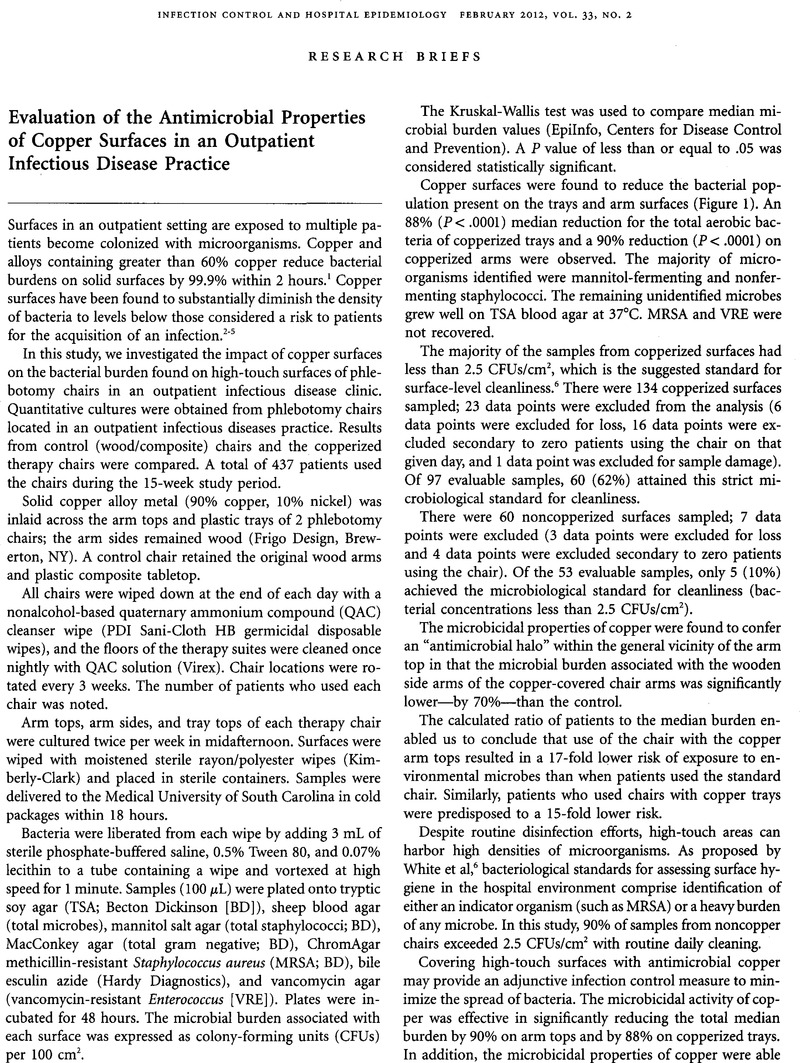Crossref Citations
This article has been cited by the following publications. This list is generated based on data provided by Crossref.
Mathews, Salima
Hans, Michael
Mücklich, Frank
and
Solioz, Marc
2013.
Contact Killing of Bacteria on Copper Is Suppressed if Bacterial-Metal Contact Is Prevented and Is Induced on Iron by Copper Ions.
Applied and Environmental Microbiology,
Vol. 79,
Issue. 8,
p.
2605.
Weber, David J.
and
Rutala, William A.
2013.
Self-disinfecting surfaces: Review of current methodologies and future prospects.
American Journal of Infection Control,
Vol. 41,
Issue. 5,
p.
S31.
Weber, David J.
Anderson, Deverick
and
Rutala, William A.
2013.
The role of the surface environment in healthcare-associated infections.
Current Opinion in Infectious Diseases,
Vol. 26,
Issue. 4,
p.
338.
Zeiger, Marco
Solioz, Marc
Edongué, Hervais
Arzt, Eduard
and
Schneider, Andreas S.
2014.
Surface structure influences contact killing of bacteria by copper.
MicrobiologyOpen,
Vol. 3,
Issue. 3,
p.
327.
Park, Geun Woo
Cho, Min
Cates, Ezra L.
Lee, David
Oh, Byung-Taek
Vinjé, Jan
and
Kim, Jae-Hong
2014.
Fluorinated TiO2 as an ambient light-activated virucidal surface coating material for the control of human norovirus.
Journal of Photochemistry and Photobiology B: Biology,
Vol. 140,
Issue. ,
p.
315.
Monk, Alastair B
Kanmukhla, Vikram
Trinder, Ken
and
Borkow, Gadi
2014.
Potent bactericidal efficacy of copper oxide impregnated non-porous solid surfaces.
BMC Microbiology,
Vol. 14,
Issue. 1,
p.
57.
Mathews, Salima
Kumar, Ranjeet
Solioz, Marc
and
Drake, H. L.
2015.
Copper Reduction and Contact Killing of Bacteria by Iron Surfaces.
Applied and Environmental Microbiology,
Vol. 81,
Issue. 18,
p.
6399.
Vincent, Marin
Hartemann, Philippe
and
Engels-Deutsch, Marc
2016.
Antimicrobial applications of copper.
International Journal of Hygiene and Environmental Health,
Vol. 219,
Issue. 7,
p.
585.
Hans, Michael
Mathews, Salima
Mücklich, Frank
and
Solioz, Marc
2016.
Physicochemical properties of copper important for its antibacterial activity and development of a unified model.
Biointerphases,
Vol. 11,
Issue. 1,
Hinsa-Leasure, Shannon M.
Nartey, Queenster
Vaverka, Justin
and
Schmidt, Michael G.
2016.
Copper alloy surfaces sustain terminal cleaning levels in a rural hospital.
American Journal of Infection Control,
Vol. 44,
Issue. 11,
p.
e195.
Hutchins, C.F.
Moore, G.
Thompson, K.-A.
Webb, J.
and
Walker, J.T.
2017.
Contamination of hospital tap water: the survival and persistence of Pseudomonas aeruginosa on conventional and ‘antimicrobial’ outlet fittings.
Journal of Hospital Infection,
Vol. 97,
Issue. 2,
p.
156.
Souli, Maria
Antoniadou, Anastasia
Katsarolis, Ioannis
Mavrou, Irini
Paramythiotou, Elisabeth
Papadomichelakis, Evangelos
Drogari-Apiranthitou, Maria
Panagea, Theofano
Giamarellou, Helen
Petrikkos, George
and
Armaganidis, Apostolos
2017.
Reduction of Environmental Contamination With Multidrug-Resistant Bacteria by Copper-Alloy Coating of Surfaces in a Highly Endemic Setting.
Infection Control & Hospital Epidemiology,
Vol. 38,
Issue. 7,
p.
765.
Colin, Marius
Klingelschmitt, Flora
Charpentier, Emilie
Josse, Jérôme
Kanagaratnam, Lukshe
De Champs, Christophe
and
Gangloff, Sophie
2018.
Copper Alloy Touch Surfaces in Healthcare Facilities: An Effective Solution to Prevent Bacterial Spreading.
Materials,
Vol. 11,
Issue. 12,
p.
2479.
Esolen, Lisa M.
Thakur, Lokendra
Layon, Abraham J.
Fuller, Thomas A.
Harrington, Deni-Jo
Jha, Kunal
and
Kariyawasam, Subhashinie
2018.
The efficacy of self-disinfecting bedrail covers in an intensive care unit.
American Journal of Infection Control,
Vol. 46,
Issue. 4,
p.
417.
Chyderiotis, S.
Legeay, C.
Verjat-Trannoy, D.
Le Gallou, F.
Astagneau, P.
and
Lepelletier, D.
2018.
New insights on antimicrobial efficacy of copper surfaces in the healthcare environment: a systematic review.
Clinical Microbiology and Infection,
Vol. 24,
Issue. 11,
p.
1130.
Arendsen, Linda P.
Thakar, Ranee
and
Sultan, Abdul H.
2019.
The Use of Copper as an Antimicrobial Agent in Health Care, Including Obstetrics and Gynecology.
Clinical Microbiology Reviews,
Vol. 32,
Issue. 4,
Mitra, Debirupa
Kang, En-Tang
and
Neoh, Koon Gee
2020.
Antimicrobial Copper-Based Materials and Coatings: Potential Multifaceted Biomedical Applications.
ACS Applied Materials & Interfaces,
Vol. 12,
Issue. 19,
p.
21159.
Schmidt, M.G.
2020.
Decontamination in Hospitals and Healthcare.
p.
259.
Landry, Kyle S
Morey, Jose M
Bharat, Bharat
Haney, Nora M
and
Panesar, Sandip S
2020.
Biofilms—Impacts on Human Health and Its Relevance to Space Travel.
Microorganisms,
Vol. 8,
Issue. 7,
p.
998.
Dauvergne, Emilie
and
Mullié, Catherine
2021.
Brass Alloys: Copper-Bottomed Solutions against Hospital-Acquired Infections?.
Antibiotics,
Vol. 10,
Issue. 3,
p.
286.





